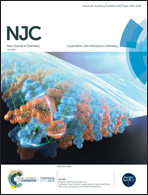Synthesis, photophysical and electroluminescent properties of iridium(iii) complexes with 2-aryl-thiazole and oxadiazol-substituted amide derivative ligands†
Abstract
By using aryl-thiazoles as cyclometalated ligands and an oxadiazol-substituted amide as the ancillary ligand, three novel iridium(III) complexes have been synthesized and characterized, and their photophysical and electrochemical properties have been investigated. Complexes 1–3 exhibit efficient phosphorescence emissions at 542, 555 and 585 nm with photoluminescence quantum yields (PLQYs) of 0.04, 0.03 and 0.02 in CH3CN solutions, respectively. In the 10 wt% doped 2,4-diphenyl-6-bis(12-phenylindolo)[2,3-a]carbazole-11-yl)-1,3,5-triazine (Dictrz) film, the PLQYs (0.88 for complex 1, 0.47 for complex 2 and 0.37 for complex 3) increase significantly owing to the great restriction of rotations and vibrations in the rigid host. The organic light-emitting diodes based on these complexes show good performance with maximum current efficiencies of 20.06, 22.20 and 13.45 cd A−1 and maximum power efficiencies of 13.54, 17.31 and 9.48 lm W−1 with CIE coordinates of (0.46, 0.53), (0.49, 0.50) and (0.59, 0.40) for complexes 1–3, respectively.



 Please wait while we load your content...
Please wait while we load your content...